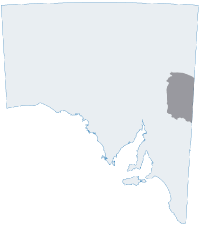
The Curnamona Province is a 300 by 300 km block of shallow to outcropping basement rocks located 450 km northeast of Adelaide. Primarily situated in South Australia, it extends eastward from Olary across the border into New South Wales and includes the rocks hosting the Broken Hill ore body.
Age of major events
- Willyama Supergroup deposition ~1720–1640 Ma
- Broken Hill Pb-Zn-Ag mineralisation ~1685 Ma
- Olarian Orogeny deformation and metamorphism ~1620–1580 Ma
- Ninnerie Supersuite bimodal volcanism and intrusive magmatism ~1590–1580 Ma
- Radium Creek Group deposition and volcanism ~1590–1580 Ma
- Moolawatana Suite felsic intrusions ~1560–1550 Ma
- Paleozoic Mount Painter uranium mineralisation sourced from older rocks
- Mesozoic weathering and marine sedimentation
- Cenozoic paleochannels, terrestrial sedimentation, uranium mineralisation
Prospective commodities
Metals: Cu, Au, Zn, Pb, Ag, U, REE, Sn, W, beryl, garnet and fluorite
Industrial minerals: limestone, dolomite, barite, vein-silica, manganese oxide, barite, wollastonite, feldspar, corundum, regolith kaolin and clay (brickmaking and refractory)
Gem: andalusite, beryl
Construction materials: road making material (limestone, dolomite, quartzite, sandstone, gneiss), dimension stone (granite)
Energy minerals: U3O8, thorium, yttrium, REE
Major exploration models
Demonstrated
- Broken Hill type Pb–Zn–Ag deposits
- Unconformity and Paleochannel U (derived from Mount Painter Inlier (MPI))
- Tin (volcanic hosted)
- Sedimentary-hosted Cu, U - eg Gunsight - MPI
- Shear-hosted Cu, Mo - eg Parabarana- MPI
- Shear to unconformity-related uranium - eg modified Mesoproterozoic granites - MPI
- Regolith deposits, including kaolin
- Monazite and associated REE and phosphorous
Possible
- Iron oxide copper gold (IOCG) deposits
- Structure related magnetite-copper-gold
- Vein gold
- “Epithermal-style” - eg Mount Gee-MPI
- Intrusion-related W - eg northern MPI
- Regolith deposits, including U and REE hosted kaolin
Summary geology
The Curnamona Province is a large, near-circular area of Paleoproterozoic to Mesoproterozoic rocks in the northeast of South Australia, partially extending into western New South Wales. The province lies east of the Archean to Mesoproterozoic Gawler Craton from which it is separated by a Neoproterozoic to Cambrian rift and sag basin complex. The Curnamona Province is largely obscured by younger Cambrian to Cenozoic sedimentary rocks, particularly in the central region. Outcrops are restricted to a series of inliers, known as the Willyama Inlier, in the Olary-Broken Hill region in the south and the Mount Painter and Mount Babbage Inliers in the northwest.
The Curnamona Province is divided into eight domains based on sedimentary facies, volcanic, tectonic and metamorphic characteristics. The domains include Olary Domain in the southwest, Broken Hill Domain and Redan Domain in the southeast (the former is largely in NSW but extends a short distance into SA), Mulyungarie Domain in the centre and straddling the state border and Moolawatana Domain in the northwest. The Mudguard Domain overlies the central portion of the province, separating two deeply buried domains, the Erudina Domain in the west and Quinyambie Domain in the east.
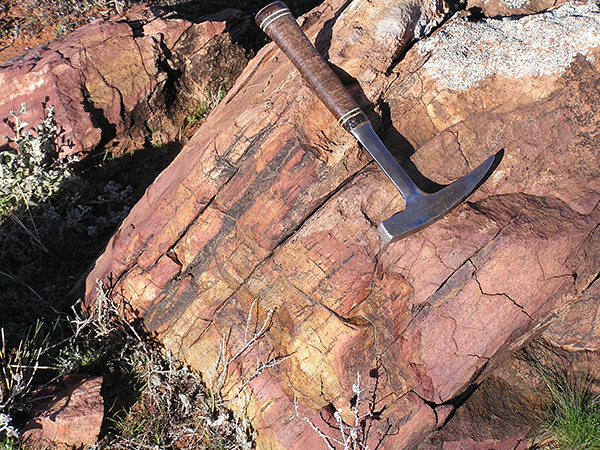
Red weathering layered quartz-eye metarhyolite with magnetite bands. (Photo 413677)
Metasedimentary rocks of the Willyama Supergroup crop out in the Olary Domain and Broken Hill Domain. The Willyama Supergroup comprises greenschist to granulite facies metasedimentary rocks with lesser bimodal meta-volcanic intercalations deposited between ~1720 and 1640 Ma. This formed part of an extensive late Paleoproterozoic basin complex at the eastern margin of the Australian Precambrian craton with the ~1695 Ma volcaniclastic Hores Gneiss of the Broken Hill Domain hosting the giant Pb-Zn-Ag Broken Hill Deposit in western New South Wales.
No basal unconformity or basement to the Willyama Supergroup is known. The oldest exposed rocks are the Curnamona Group in the Olary Domain comprising commonly albitised, fine to medium-grained, shallow-water siliciclastic metasedimentary rocks. Felsic and mafic lavas and volcaniclastic intercalations range in age from 1716 to 1710 Ma (U-Pb Ca-TIMS ages on volcanic zircons). Minor facies variations include pure and feldspathic quartzite, clean cross-bedded metasandstone, pelite, psammopelite, calc-silicate, calc-albitite and rare marble. Felsic granites of the Ameroo Subsuite were intruded into the Curnamona Group at ~1710 Ma.
In the Broken Hill Domain, the lower Willyama Supergroup is represented by the Rantyga and Thackaringa Groups, comprised of albitic and migmatitic paragneisses , dated at ~1710–1705 Ma. Intrusive felsic rocks of the Silver City Suite (~1705–1683 Ma) occur as granite sills in the Thackaringa Group and the overlying Broken Hill Group.
Sedimentary rocks of this age (~1710–1705 Ma) are absent in the Olary Domain, representing a hiatus in sedimentation of some 15 m.y. after the Curnamona Group deposition.
Sedimentation resumed in the Olary Domain and continued in the Broken Hill Domain from ~1695 to ~1670 Ma with the deposition of the Saltbush Group and the Broken Hill and Sundown groups respectively. At the base, respectively, are the equivalent units the Bimba Formation and Ettlewood Calc-silicate Member. These comprise variable, base metal-anomalous units of basal quartzite followed by biotite-speckled metasandstone, calc-silicate and marble. Sulphide occurs throughout the Bimba Formation. The Bimba Formation is conformably overlain by volcaniclastic psammite and graphitic metasiltstone of the Plumbago Formation dated at ~1695 Ma and a similar-aged volcaniclastic metasiltstone is found in the Broken Hill Domain directly overlying the Ettlewood Calc-silicate Member.
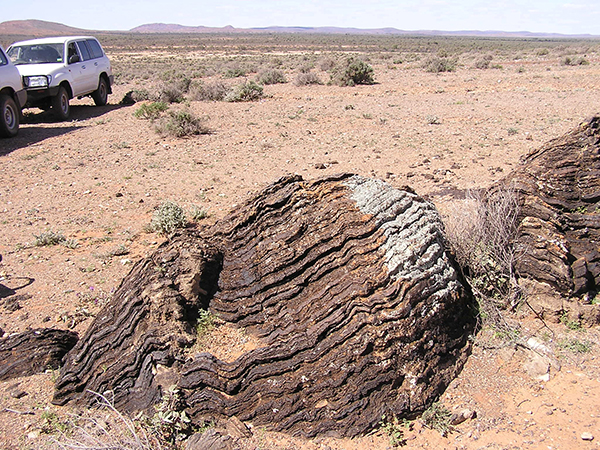
Crumpled bedding in layered calc-silicate, Bimba Formation, north of Alconie Hill. (Photo 413662)
The Raven Hill Subgroup (within the Saltbush Group, Olary Domain) is tentatively correlated with the Broken Hill Group which is host to the Pb-Zn-Ag orebody at Broken Hill. Equivalent felsic intrusive rocks to Hores Gneiss (~1683 Ma) have been found in the Olary Domain at east Mingary and mafic intrusive rocks of a similar age (~1685 Ma) known as the Lady Louise Suite are found in the Olary Domain.
Upper portions of the Saltbush Group, the Walparuta Subgroup, comprise bedded pelite to psammopelite layers and are equivalent to the Sundown Group in the Broken Hill Domain.
The uppermost Willyama Supergroup include the Strathearn Group and Paragon Group in the Olary and Broken Hill domains respectively. The Strathearn Group extends northward from the Olary Domain into the largely subsurface Mulyungarie Domain. The outcropping portion is the Mount Howden Subgroup, directly correlated with the Paragon Group of the Broken Hill Domain by U-Pb SHRIMP geochronology on volcaniclastic zircons (~1650–1640 Ma) in metasandstone intercalations in carbonaceous pelitic metasediments. The Mooleulooloo Formation comprises thinly intercalated albitic psammites with local siliceous concretions and brown mica schists. It forms a distinct marker horizon on regional gravity imagery and is considered to be equivalent to the Bijerkerno Metasediments of the Paragon Group, Broken Hill Domain. Deposition of the Willyama Supergroup ceased at ~1640 Ma.
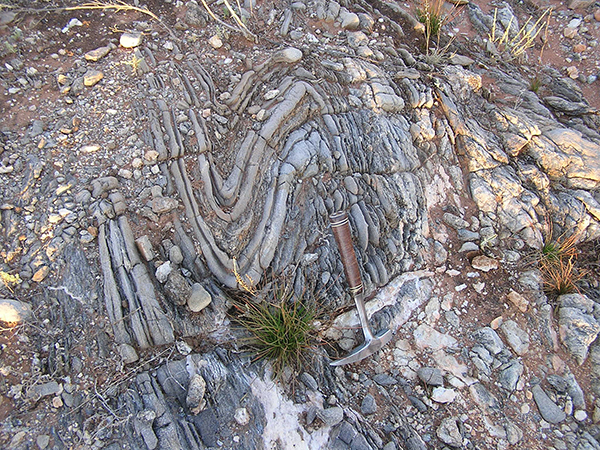
Steeply plunging S-fold in thinly interbedded psammite and pelite, with axial plane crenulation cleavage. Black Maria Formation, Mulga Creek. (Photo 413668)
The Olarian Orogeny, involving major crustal shortening with overall northwest-directed tectonic transport, may have commenced by ~1620 Ma and was accompanied by high-temperature low-pressure metamorphism, increasing in grade from greenschist facies in the centre of the Curnamona Province to granulite facies at Broken Hill in the southeast. Early folds were of isoclinal recumbent style, commonly sheath-like, accompanied by west or northwest-directed thrusting and mostly layer-parallel foliation. Later folds tend to be more upright, but with major plunge reversals and mostly northeasterly trends. These folds define the arcuate, dominantly northeast-trending tectonic grain of the southern Curnamona Province. Deformation is likely to have been continuous and progressive.
The Ninnerie Supersuite was generated late in the deformation history of the Olarian Orogeny, producing vast quantities of granites and felsic volcanic rocks, and minor mafic to intermediate magmatic rocks. The supersuite comprises four suites, three of which are exposed at the surface. Exposed units include muscovite-biotite granites of the Bimbowrie Suite (Olary Domain), biotite-muscovite, biotite-only and sodic granites of the Crocker Well Suite, and felsic granites and volcanic rocks of the Coulthard Suite in the Mount Painter Inlier. The fourth suite comprises unexposed basaltic and dacite-rhyolite volcanic rocks in the Benagerie Ridge, Mudguard Domain. Basaltic lavas are interlayered with sedimentary rocks which could be equivalent to mafic lavas and lacustrine sedimentary rocks of the lower Gawler Range Volcanics in the Roopena Basin. Felsic lavas of the Benagerie Volcanic Suite are equivalent to the upper Gawler Range Volcanics, displaying both geochemical and temporal affinity (precise U-Pb zircon geochronology magmatic ages of ~1586 Ma for both units). Crocker Well Suite are associated with uranium mineralisation in the western Olary domain, and volcanic rocks and sub-volcanic intrusions in the Mudguard Domain are prospective for iron oxide-copper-gold (IOCG) mineralisation. After granite intrusion, a system of anastomosing and conjugate greenschist facies shear zones cut the whole orogen with E-W, WNW and ENE trends, and local E-W folding suggests some N-S compression. The arcuate shape of the tectonic trends may have been imposed at this time, while the most deeply buried rocks in the south were progressively exhumed. In the central portion of the province, Benagerie Volcanic Suite were extruded onto the less deeply eroded surface of the Willyama Supergroup.
In the Moolawatana Domain, fine to coarse-grained, generally upward-coarsening siliciclastic and volcanogenic sediments of the Radium Creek Group were probably deposited synchronously with the Olarian Orogeny, possibly in a foreland basin related to a northwestern Olarian thrust front. The Radium Creek Group was intruded by Ninnerie Supersuite (~1580 Ma) and Moolawatana Suite (~1560–1550 Ma) granites and has subsequently been subjected to several folding and metamorphosing events including the Delamerian Orogeny at ~510–490 Ma. These two granitic suites consist of some of the most highly anomalously uranium-rich granites known.
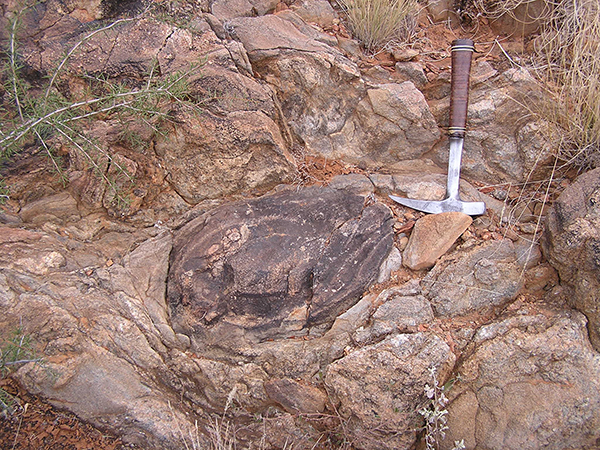
Calc-silicate ellipsoid (metamorphosed lime concretion) in pelitic schist, Oonartra Creek Formation, near Mount Mulga. (Photo 413671)
The Proterozoic basement of the Curnamona Province was onlapped by various Adelaidean (Neoproterozoic) and Cambrian sedimentary rocks. The marginal zones of the province were affected by early and middle Neoproterozoic and Early Cambrian rifting events, and by deformation and low-grade metamorphism in the Cambrian Delamerian Orogeny. Consequently, the edges of the province are limits of a crustal remnant encircled by Neoproterozoic and Palaeozoic mobile belts which have been greatly attenuated and subsided to deep levels beneath thick sedimentary accumulations.
In the Mount Painter Inlier, magmatic, hydrothermal and uranium mineralisation continued into the mid-Palaeozoic to Mesozoic, as well as magmatic intrusive activity resulting from melting the Mesoproterozoic rocks. Also, localised high-grade metamorphism of these older rocks in the mid-Palaeozoic produced monazite rich schists with anomalous REE as well as local migmitisation.
The Mulyungarie Domain was onlapped and overlain by Mesozoic marine and glacial sediments of the Frome Embayment and by Cenozoic sediments of the Callabonna Sub-basin. In the Eocene, palaeochannels were eroded into the basement rocks. Eocene channel deposits and Miocene lacustrine sediments are both host to significant uranium mineralisation derived from adjacent uraniferous basement rocks. Uranium has been extracted by in-situ leaching at Beverley and Honeymoon.
Armit RJ, Betts PG, Schaefer BF, Pankhurst MJ and Giles D 2014. Provenance of the Early Mesoproterozoic Radium Creek Group in the northern Mount Painter Inlier: Correlating isotopic signatures to inform tectonic reconstructions. Precambrian Research 243:63–87. https://doi.org/10.1016/j.precamres.2013.12.022
Barovich K and Hand M 2008. Tectonic setting and provenance of the Paleoproterozoic Willyama Supergroup, Curnamona Province, Australia: Geochemical and Nd isotopic constraints on contrasting source terrain components. Precambrian Research 166:318–337. https://doi.org/10.1016/j.precamres.2007.06.024
Conor CHH and Preiss WV 2008. Understanding the 1720–1640Ma Palaeoproterozoic Willyama Supergroup, Curnamona Province, southeastern Australia: implications for tectonics, basin evolution and ore genesis. Precambrian Research 166:297–317. https://doi.org/https://doi.org/10.1016/j.precamres.2007.08.020
Fricke CE and Hore S 2011. Definition of the Mesoproterozoic Ninnerie Supersuite, Curnamona Province, South Australia. Report Book 2010/00020. Department of Primary Industries and Resources South Australia. https://sarigbasis.pir.sa.gov.au/WebtopEw/ws/samref/sarig1/image/DDD/RB201000020.pdf
Jagodzinski E, Kositcin N, Michael U and Bodorkos S 2023. 2023 data release of U-Pb dates for the Curnamona Province in South Australia: advances in the stratigraphy of the Olary Domain. Australian Earth Sciences Convention 2023, Perth. https://sarigbasis.pir.sa.gov.au/WebtopEw/ws/plans/sarig1/image/DDD/205746-001
Page RW, Stevens BPJ and Gibson GM 2005a. Geochronology of the Sequence Hosting the Broken Hill Pb-Zn-Ag Orebody, Australia. Economic Geology 100:633–661. doi:10.2113/100.4.633
Page RW, Conor CHH, Stevens BPJ, Gibson GM, Preiss WV and Southgate PN. 2005b. Correlation of Olary and Broken Hill Domains, Curnamona Province: possible relationship to Mount Isa and other north Australian Pb – Zn – Ag-bearing successions. Economic Geology 100:663–676. doi:10.2113/100.4.663
Raveggi M, Giles D, Foden J and Raetz M 2007. High Fe-Ti mafic magmatism and tectonic setting of the Paleoproterozoic Broken Hill Block, NSW, Australia. Precambrian Research 156:55–84. https://doi.org/10.1016/j.precamres.2007.02.006
Raveggi M, Giles D, Foden J, Raetz M and Ehlers K 2008. Source and significance of the felsic magmatism in the Palaeoproterozoic to Mesoproterozoic Broken Hill Block, New South Wales. Australian Journal of Earth Sciences 55:531–533. https://doi.org/10.1080/08120090801888651
Rutherford L, Barovich K, Hand M and Foden J 2006. Continental ca 1.7–1.69 Ga Fe-rich metatholeiites in the Curnamona Province, Australia: a record of melting of a heterogeneous, subduction-modified lithospheric mantle. Australian Journal of Earth Sciences 53:501–519. https://doi.org/10.1080/08120090600632466
Sheard MJ 2009. Explanatory Notes for CALLABONNA 1:250 000 Geological Map, sheet SH 54-6. South Australia. Report Book 2009/00001. Department of Primary Industries and Resources South Australia.
https://sarigbasis.pir.sa.gov.au/WebtopEw/ws/samref/sarig1/image/DDD/RB200900001.pdf
Sheard MJ and Wade CE 2012. MARREE 1:250 000 geological map (2nd edition) and explanatory notes. MESA Journal 64:18–24. Department of Primary Industries and Resources. https://sarigbasis.pir.sa.gov.au/WebtopEw/ws/samref/sarig1/image/DDD/MESAJ064018-024.pdf
Stewart KP and Foden J 2003. Mesoproterozoic granites of South Australia. Report Book 2003/00015. Department of Primary Industries and Resources South Australia. https://sarigbasis.pir.sa.gov.au/WebtopEw/ws/samref/sarig1/image/DDD/RB200300015.pdf
Stevens BPJ, Page RW and Crooks 2008. Geochronology of Willyama Supergroup metavolcanics, metasediments and contemporaneous intrusions, Broken Hill, Australia. Australian Journal of Earth Sciences 55(3):301–330. doi:10.1080/08120090701769456
Wade CE 2011. Definition of the Mesoproterozoic Ninnerie Supersuite, Curnamona Province, South Australia. MESA Journal 62:35–52. Department of Primary Industries and Resources South Australia. https://sarigbasis.pir.sa.gov.au/WebtopEw/ws/samref/sarig1/image/DDD/MESAJ062025-042.pdf
Wade CE, Reid A, Wingate MTD, Jagodzinski EA and Barovich K 2012. Geochemistry and geochronology of the c. 1585 Ma Benagerie Volcanic Suite, southern Australia: relationship to the Gawler Range Volcanics and implications for the petrogenesis of a Mesoproterozoic silicic large igneous province. Precambrian Research 206–207:17–35. https://doi.org/https://doi.org/10.1016/j.precamres.2012.02.020


